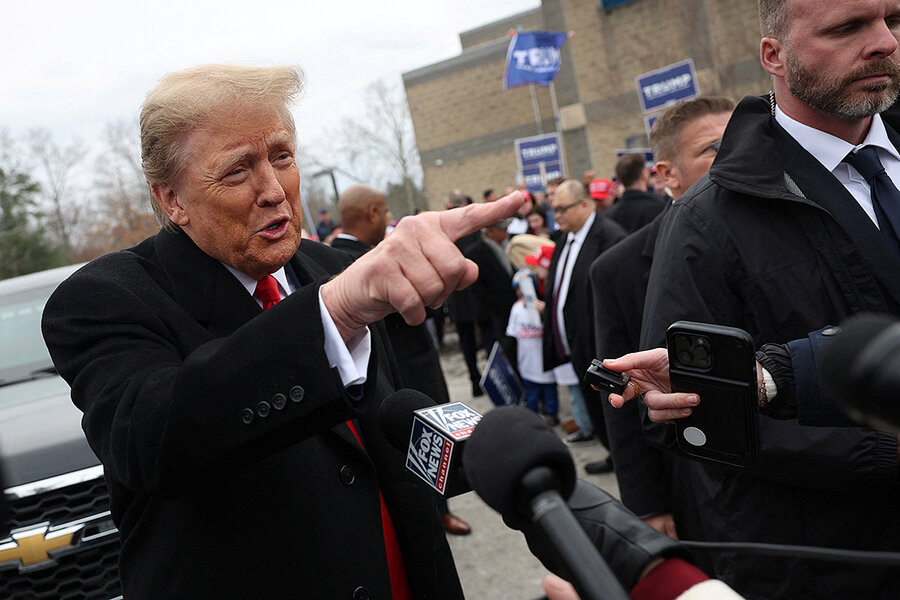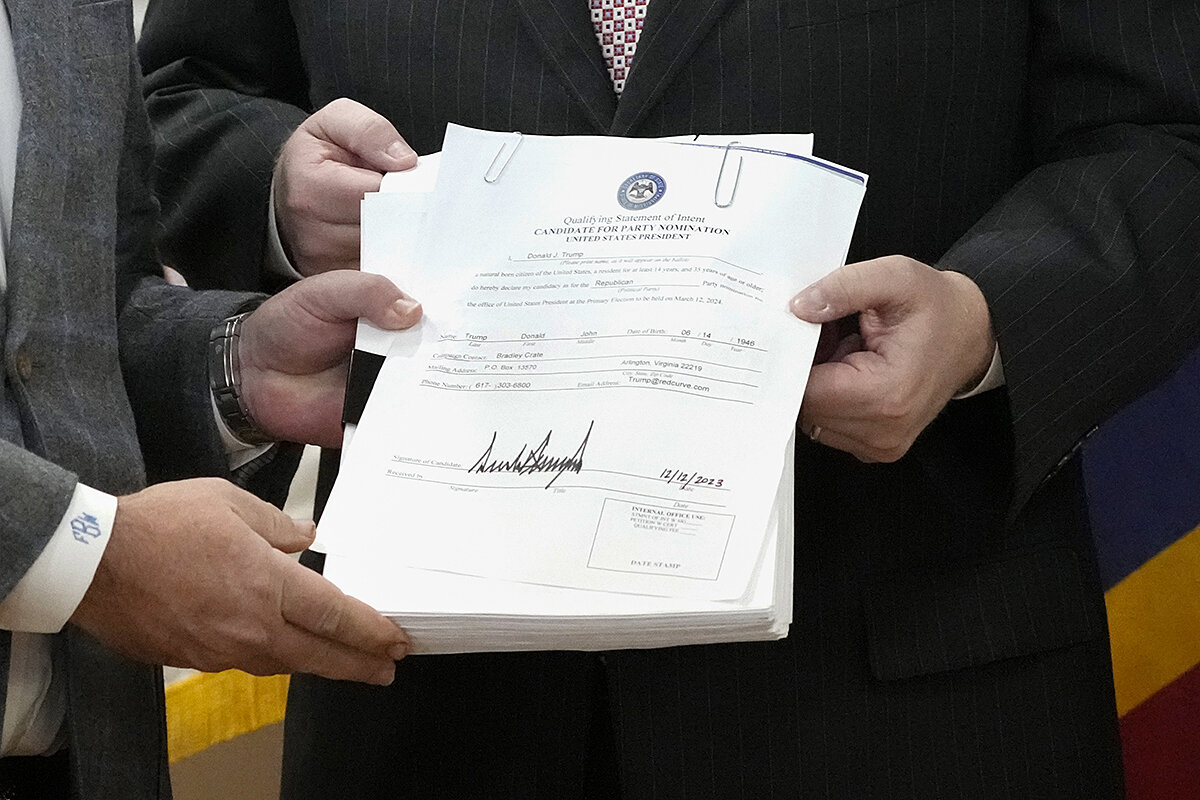Donald Trump, the Supreme Court, and the 14th Amendment
Loading...
Next month the Supreme Court of the United States will have to decide a seemingly straightforward but monumental question: Is the presidency included in a constitutional provision barring insurrectionists from federal office?
The case, Trump v. Anderson, challenges a ruling from the Colorado Supreme Court that former President Donald Trump – the current front-runner for the 2024 Republican nomination – is disqualified by Section 3 of the 14th Amendment. That provision, enacted after the Civil War, bars anyone who “engaged in insurrection” from holding public office.
But that ruling overturned the decision of a trial judge in Denver. Both the trial judge and the state Supreme Court agreed that Mr. Trump “engaged in insurrection” in the days leading up to and during the Jan. 6, 2021, attack on the Capitol. But the trial judge determined that Section 3 doesn’t apply to Mr. Trump, since Section 3 doesn’t explicitly mention the president.
Why We Wrote This
The U.S. Supreme Court will make a historic ruling this year on whether the Constitution disqualifies Donald Trump from running for president. Ahead of the oral argument next month, the Monitor is previewing the most important questions in the unprecedented case. To read the first installment, click here.
That question is one of several complex and rarely litigated issues the U.S. Supreme Court will be asked to resolve in the case. The decision the justices ultimately reach will be among the most important the court has ever made.
In the abstract, the question might seem absurd. How could a constitutional provision drafted with the goal of keeping ex-Confederates from gaining power in the federal government not include the most powerful office in that government? For a high court in which originalism – the judicial philosophy that the Constitution should be interpreted in line with the framers’ thinking – holds significant sway, this analysis could be central to how it decides the case.
Yet the question is a compelling one, because the presidency is never mentioned in the provision. Instead, the clause specifies “a Senator or Representative in Congress, or elector of President and Vice-President,” as well as “any office, civil or military, under the United States,” as the positions insurrectionists are barred from holding.
What does “office” cover?
For those who believe Section 3 doesn’t cover the presidency, that exclusion speaks for itself. Also, they say, there isn’t enough historical evidence to conclude that the presidency is covered by the phrase “office ... under the United States.” Those on the other side argue the exact opposite. The office of the president isn’t specifically mentioned because it didn’t need to be, they claim, and there is ample evidence that lawmakers and the public at the time thought it was covered by the broad “any office” phrase.
Mark Graber, a professor at the University of Maryland Francis King Carey School of Law who believes Section 3 does cover Mr. Trump, describes it as “the George Washington five-finger problem.” No one ever wrote that America’s first president had five fingers on his right hand, so how do we know he did? The likely answer: It was so unremarkable, it passed without comment.
Instead, those on this side of the debate argue that the framers of Section 3 clarified only what they thought needed clarification. There was a lot of thought at the time that senators and representatives held a “seat” instead of an “office,” according to Gerard Magliocca, a professor at the Indiana University McKinney School of Law. And given that they only serve a temporary function every four years, do electors hold an “office”?
When Congress began drawing up the 14th Amendment in 1866, an early draft of Section 3 that specifically included the president was never adopted. During Senate debates of the amendment, there was only one mention of the presidency, when Sen. Reverdy Johnson commented that he did “not see” the presidency or vice presidency. “Why did you omit to exclude them?” he asked. At that point Sen. Lott Morrill jumped in with, “Let me call the Senator’s attention to the words ‘or hold any office, civil or military, under the United States.’”
Beyond that, some scholars point to newspaper coverage around the country in ensuing years indicating that, per Section 3, Confederate leaders would be eligible for the presidency only if Congress granted them amnesty. President Andrew Johnson in proclamations also referred to the president as an “officer of the United States.”
“What reason would [the framers] have for saying, ‘You can’t be a federal officer, but you can be president of the United States?’” asks Dr. Graber.
“The Supreme Court doesn’t want to be laughed at,” he adds. “This [argument] doesn’t pass the laugh test.”
What does Section 3 say?
Critics of this argument believe they have more authoritative historical evidence: other provisions of the Constitution. The impeachment, appointments, and commissions clauses, among others, specify that the president is separate from “officers of the United States.”
A 1799 ruling by the Senate and an 1833 treatise on the Constitution from Justice Joseph Story reinforce that interpretation. The discussion of Section 3 in Congress and around the country during its ratification is too vague to conclude otherwise, they claim.
“Frankly, a single debate in Congress isn’t enough to dictate original meaning,” says Josh Blackman, a professor at the South Texas College of Law Houston, who argues that Section 3 doesn’t cover the presidency.
“Instead of speculating on what the framers intended, we should focus on what the words they chose are,” he adds.
Two months ago, federal district court Judge Sarah Wallace reached the same conclusion. While “there are persuasive arguments on both sides,” she wrote, “the court ... is unpersuaded that the drafters intended to include the highest office in the Country in the catchall phrase ‘office ... under the United States.’”
The Colorado Supreme Court disagreed. A conclusion that the presidency is “something other than an office ‘under’ the United States is fundamentally at odds with the idea that all government officials, including the President, serve ‘we the people,’” it wrote.
How much weight the U.S. Supreme Court will place on that fact is one of the defining questions of Trump v. Anderson. Scholarly research into that question has grown exponentially in the last two months. The justices and their clerks will be poring through these records and drawing their own conclusions. Given the other, more politically sensitive questions, in the case – such as whether or not Mr. Trump “engaged in insurrection” – this may be an appealing issue for the justices to resolve.







